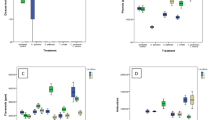Abstract
Carrageenophyte farming is an expanding economical activity in North Borneo Island, Malaysia. During routine monitoring of “ice-ice” disease and epiphyte outbreak at commercial farms, it was apparent that culture lines were heavily (60–80%) infested with biofoulers, particularly Acanthophora spp. and Laurencia majuscula. However, only L. majuscula showed dominance and flourished even during “ice-ice” disease outbreak. Presence of chemical defense against seaweed pathogens was investigated in two populations of L. majuscula collected from three major carrageenophyte farms in two districts; (A) Lohok Butun, Selakan Island, and Bum-Bum Island, in Semporna district, and (B) Telutuh, Carrington Reef, and Balambangan Island, in Kudat district. The first population contained elatol (1), and iso-obtusol (2), and, second population contained (Z)-10,15-dibromo-9-hydroxy-chamigra-1,3(15),7(14)-triene (3) and (E)-10-15-dibromo-9-hydroxy-chamigra-1,3(15),7(14)-triene (4), as their antibacterial metabolites. All four metabolites showed highly selective inhibition against “ice-ice” disease bacteria compared to human pathogens at 30 µg disk−1. In addition, seasonal variation of these compounds at two representative farms (Selakan Island [P-1] and Balambangan Island [P-2]) revealed a 120–170% increase in concentration during “ice-ice” disease outbreak. Microscopy of fresh specimens showed the presence of corps en cerise, which is the synthesis and storage site of halogenated metabolites at superficial cortical cells, branch tips, and trichoblasts. This suggests the importance of these metabolites as defense chemicals against “ice-ice” disease bacteria in L. majuscula that grows on seaweed culture lines.


Similar content being viewed by others
References
Caccamese S, Compagnini A, Toscano RM (1986) Pacifenol from the Mediterranean red alga Laurencia majuscula. J Nat Prod 49:173–174
Capon RJ, Ghisalberti EL, Mori TA, Jefferies PR (1988) Sesquiterpenes from Laurencia spp. J Nat Prod 51:1302–1304
Coll JC, Wright AD (1989) Tropical marine algae. III. New sesquiterpenes from Laurencia majuscula (Phodophyceae, Ceramiales, Rhodomelaceae). Aust J Chem 42:1591–1603
Doty MS (1973) Farming red seaweed, Eucheuma for carrageenans. Micronesica 9(1):59–73
González AG, Martín JD, Martín VS, Martinez-Ripoli M, Fayos J (1979) X ray studies of sesquiterpene constituents of the alga L. obtusa leads to structure revision. Tet Lett 2717-2718
Largo DB, Fukami F, Nishijima T (1995) Occational bacteria promoting ice-ice disease of the farmed red algae Kappaphycus alverazii and Euchema denticulatum (Solieriacea, Gigartinales, Rhodophyta). J Appl Phycol 7:545–554
Masuda M, Abe T, Sato S, Suzuki M (1997a) Diversity of halogenated secondary metabolites in the red alga Laurencia nipponica (Rhodomelaceae, Ceramiales). J Phycol 33:196–208
Masuda M, Itoh T, Matsuo Y, Suzuki M (1997b) Sesquiterpenoids of Laurencia majuscula (Ceramiales, Rhodophyta) from Ryukyu Islands, Japan. Phycol Res 45:59–64
Masuda M, Kogame K, Arisawa S, Suzuki M (1998) Morphology and halogenated secondary metabolites of three Gran Canarian species of Laurencia (Ceramiales, Rhodophyta). Bot Mar 41:265–277
Salgado LT, Viana NB, Andrade LR, Leal RN, da Gama BAP, Attias M, Pereira RC, Amado-Filho GM (2008) Intra-cellular storage, transport and exocytosis of halogenated compounds in marine red alga Laurencia obtusa. J Struct Biol 162:345–355
Sims JJ, Lin GHY, Wing RM (1974) Marine natural product X. Elatol, a halogenated sesquiterpene alcohol from the red alga Laurencia elata. Tet Lett 1974:3487–3490
Sudatti DB, Rodrigues SV, Coutinho R, da Gama BAP, Salgado LT, Filho GMA, Pereira RC (2008) Transport and defensive role of elatol at the surface of the red seaweed Laurencia obtuse (Ceramiales, Rhodophyta). J Phycol 44:584–591
Suzuki M, Kurosawa E (1978) Two new halogenated sesquiterpenes from the red alga Laurencia majuscula Harvey. Tet Lett 1978:4805–4808
Suzuki M, Furusaki A, Hashiba N, Kurosawa E (1979) The structures and absolute stereochemistry of two halogenated chamigrenes from the red alga Laurencia majuscula Harvey. Tet Lett 1979:879–882
Suzuki M, Kawamoto T, Vairappan CS, Ishii T, Abe T, Masuda M (2005) Halogenated metabolites from Japanese Laurencia spp. Phytochemistry 66:2787–2793
Uyenco FR, Saniel LS, Jacinto GS (1981) The “ice-ice” problem in seaweed farming. Xth International Seaweed Symposium. de Gruyter, Berlin, pp 625–630
Vairappan CS, Daitoh M, Suzuki M, Abe T, Masuda M (2001) Antibacterial halogenated metabolites from the Malaysian Laurencia species. Phytochemistry 58:291–97
Vairappan CS (2003) Potent antibacterial activity of halogenated metabolites from Malaysian red algae, Laurencia majuscula (Rhodomelaceae, Ceramiales). Biomol Eng 20:255–259
Vairappan CS (2006) Seasonal occurences of epiphytic algae on the commercially cultivated red alga Kappaphycus alverazii (Solieriaceae, Gigartinales, Rhodophyta). J Appl Phycol 18:611–617
Vairappan CS, Chong SC (2006) Seaweed farming in Malaysia: challenges. In: Phang SM, Critchley AT, Ang PO Jr (eds) Seaweed utilization in South East Asia. University of Malaya Maritime Research Centre (UMMReC), Kuala Lumpur, pp 161–170
Vairappan CS, Kawamoto T, Miwa H, Suzuki M (2004) Potent antibacterial activity of halogenated compounds against antibiotic-resistant bacteria. Planta Medica 70:1087–1090
Vairappan CS, Chong SC, Hurtado AQ, Soya FE, Lhonneur GB, Critchley A (2008) Distribution and symptoms of epiphyte infection in major carrageenophyte-producing farms. J Appl Phycol 20:477–483
Wright AD, Coll JC, Price IR (1990) Tropical marine algae, VII. The chemical composition of marine algae from north Queensland waters. J Nat Prod 53:845–861
Young DN, Howard BM, Fenical W (1980) Subcellular localization of brominated secondary metabolites in red algae of Laurencia snyderae. J Phycol 16:182–185
Acknowledgments
We are grateful to Sabah Parks for the support and assistance during field survey. This study was funded by the “International Foundation for Science (IFS)” and Committee for the Prohibition of Chemical Weapon, Hague, The Netherlands (IFS) and Japanese Society for the Promotion of Science (P 06215).
Author information
Authors and Affiliations
Corresponding author
Rights and permissions
About this article
Cite this article
Vairappan, C.S., Anangdan, S.P., Tan, K.L. et al. Role of secondary metabolites as defense chemicals against ice-ice disease bacteria in biofouler at carrageenophyte farms. J Appl Phycol 22, 305–311 (2010). https://doi.org/10.1007/s10811-009-9460-7
Received:
Revised:
Accepted:
Published:
Issue Date:
DOI: https://doi.org/10.1007/s10811-009-9460-7




